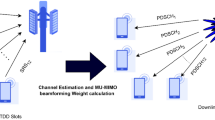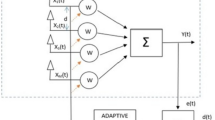Abstract
Massive multiple-input multiple-output (MIMO) enables increased throughput by using spatial multiplexing. However, the throughput may severely degrade when the number of users served by a single base station increases, especially under line-of-sight (LoS) propagation. Selecting users is a possible solution to deal with this problem. In the literature, the user selection algorithms can be divided into two classes: small-scale fading aware (SSFA) and large-scale fading aware (LSFA) algorithms. The LSFA algorithms are good solutions for massive MIMO systems under non LoS propagation since the small-scale fading does not affect the system performance under this type of propagation. For the LoS case, the small-scale fading has a great impact on the system performance, requiring the use of SSFA algorithms. However, disregarding the large-scale fading is equivalent to assuming that all users are equidistant from the base station and experience the same level of shadowing, which is not a reasonable approximation in practical applications. To address this shortcoming, a new user selection algorithm called the fading-ratio-based selection (FRBS) is proposed. FRBS considers both fading information to drop those users that induce the highest interference to the remaining ones. Simulation results considering LoS channels show that using FRBS yields near optimum downlink throughput, which is similar to that of the state-of-the-art algorithm, but with much lower computational complexity. Moreover, the use of FRBS with zero-forcing precoder resulted in 26.28% improvement in the maximum throughput when compared with SSFA algorithms, and 35.39% improvement when compared with LSFA algorithms.







Similar content being viewed by others
Notes
To allow SOS to take the large-scale fading into account, the SOS algorithm used herein does not normalize the columns of the channel matrix.
By worst case, we mean the precoder whose performance yielded the largest gap between a given algorithm (SOS or FRBS) and the benchmark curve (ESEPA). In this case, the precoder that yielded the largest performance gaps was the MRT precoder.
References
Marzetta, T. L. (2010). Noncooperative cellular wireless with unlimited numbers of base station antennas. IEEE Transactions on Wireless Communications, 9(11), 3590–3600. https://doi.org/10.1109/TWC.2010.092810.091092.
Chaves, R. S., Lima, M. V. S., Cetin, E., & Martins, W. A. (2022). User selection for massive MIMO under line-of-sight propagation. IEEE Open Journal Communication Society, 3, 867–887. https://doi.org/10.1109/OJCOMS.2022.3172621.
Rusek, F., Persson, D., Lau, B. K., Larsson, E. G., Marzetta, T. L., & Tufvesson, F. (2013). Scaling Up MIMO: Opportunities and Challenges with Very Large Arrays. IEEE Signal Processing Magazine, 30(1), 40–60. https://doi.org/10.1109/MSP.2011.2178495.
Ngo, H.Q., Larsson, E.G., & Marzetta, T.L. (2014). Aspects of favorable propagation in massive MIMO. In: 22nd European signal processing conference, Lisbon, pp. 76–80.
Yang, H. (2018). User scheduling in massive MIMO. In: IEEE 19th International Workshop Signal Process. Advance Wireless Communication, Kalamata, pp. 1–5. https://doi.org/10.1109/SPAWC.2018.8445907
Yoo, T., & Goldsmith, A. (2006). On the optimality of multiantenna broadcast scheduling using zero-forcing beamforming. IEEE Journal on Selected Areas in Communications, 24(3), 528–541. https://doi.org/10.1109/JSAC.2005.862421.
Yang, H., & Marzetta, T. L. (2017). Massive MIMO with max-min power control in line-of-sight propagation environment. IEEE Transactions on Communications, 65(11), 4685–4693. https://doi.org/10.1109/TCOMM.2017.2725262.
Farsaei, A., Alvarado, A., Willems, F. M. J., & Gustavsson, U. (2019). An improved dropping algorithm for line-of-sight massive MIMO with max-min power control. IEEE Communications Letters, 23(6), 1109–1112. https://doi.org/10.1109/LCOMM.2019.2912601.
Chaves, R. S., Cetin, E., Lima, M. V. S., & Martins, W. A. (2021). User selection based on inter-channel interference for massive MIMO under line-of-sight propagation. In: XXXIVth General assembly and scientific symposium of the international union of radio science, Rome, pp. 1–4. https://doi.org/10.23919/URSIGASS51995.2021.9560387
Lu, L., Li, G. Y., Swindlehurst, A. L., Ashikhmin, A., & Zhang, R. (2014). An overview of massive MIMO: benefits and challenges. IEEE Journal of Selected Topics in Signal Processing, 8(5), 742–758. https://doi.org/10.1109/JSTSP.2014.2317671.
Marzetta, T. L., Larsson, E. G., Yang, H., & Ngo, H. Q. (2016). Fundamentals of massive MIMO (1st ed., p. 220). Cambridge: Cambridge University Press.
Bashar, M., Cumanan, K., Burr, A. G., Ngo, H. Q., Larsson, E. G., & Xiao, P. (2019). Energy efficiency of the cell-free massive MIMO uplink with optimal uniform quantization. IEEE Transactions on Green Communications and Networking, 3(4), 971–987. https://doi.org/10.1109/TGCN.2019.2932071.
Chen, S., Zhang, J., Björnson, E., Zhang, J., & Ai, B. (2021). Structured Massive Access for Scalable Cell-Free Massive MIMO Systems. IEEE Journal on Selected Areas in Communications, 39(4), 1086–1100. https://doi.org/10.1109/JSAC.2020.3018836.
Farsaei, A., Alvarado, A., Willems, F. M. J., & Gustavsson, U. (2019). An improved dropping algorithm for line-of-sight massive MIMO with tomlinson-harashima precoding. IEEE Communications Letters, 23(11), 2099–2103. https://doi.org/10.1109/LCOMM.2019.2934680.
Tan, C. W. (2014). Wireless network optimization by Perron-Frobenius Theory. In: 48th Annual conference on information sciences and systems, pp. 1–6. IEEE, Princeton. https://doi.org/10.1109/CISS.2014.6814130
Chien, T. V., Björnson, E., & Larsson, E. G. (2016). Joint power allocation and user association optimization for massive MIMO systems. IEEE Transactions on Wireless Communications, 15(9), 6384–6399. https://doi.org/10.1109/TWC.2016.2583436.
Chien, T. V., Björnson, E., & Larsson, E. G. (2018). Joint pilot design and uplink power allocation in multi-cell massive MIMO systems. IEEE Transactions on Wireless Communications, 17(3), 2000–2015. https://doi.org/10.1109/TWC.2017.2787702.
ETSI 3GPP: Digital cellular telecommunications system (phase 2+); radio network planning aspects. Technical report, ETSI (2010).
van Trees, H. L. (2002). Optimum array processing (1st ed., p. 1443). New York: Wiley.
Björnson, E., Hoydis, J., & Sanguinetti, L. (2017). Massive MIMO networks: Spectral, energy, and hardware efficiency. Foundations and Trends® in Signal Processing. https://doi.org/10.1561/2000000093.
Chaves, R. S., Cetin, E., Lima, M. V. S., & Martins, W. A. (2020). On the convergence of max-min fairness power allocation in massive MIMO systems. IEEE Communications Letters, 24(12), 2873–2877. https://doi.org/10.1109/LCOMM.2020.3014942.
Ozdogan, O., Björnson, E., & Larsson, E. G. (2019). Massive MIMO with spatially correlated rician fading channels. IEEE Transactions on Communications, 67(5), 3234–3250. https://doi.org/10.1109/TCOMM.2019.2893221.
Sanguinetti, L., Bjornson, E., & Hoydis, J. (2020). Toward Massive MIMO 2.0: Understanding spatial correlation, interference suppression and pilot contamination. Transactions on Communications, 68(1), 232–257.
Björnson, E., Hoydis, J., Kountouris, M., & Debbah, M. (2014). Massive MIMO systems with non-ideal hardware: Energy efficiency, estimation, and capacity limits. IEEE Transactions on Information Theory, 60(11), 7112–7139. https://doi.org/10.1109/TIT.2014.2354403.
Liu, H., Gao, H., Yang, S., & Lv, T. (2017). Low-complexity downlink user selection for massive MIMO systems. IEEE Systems Journal, 11(2), 1072–1083. https://doi.org/10.1109/JSYST.2015.2422475.
Lee, G., & Sung, Y. (2018). A new approach to user scheduling in massive multi-user MIMO broadcast channels. IEEE Transactions on Communications, 66(4), 1481–1495. https://doi.org/10.1109/TCOMM.2017.2786670.
Acknowledgements
This work was in part supported by the Coordenação de Aperfeiçoamento de Pessoal de Nível Superior - Brasil (CAPES) - Finance Code 001, the International Macquarie University Research Excellence Scholarship (iMQRES) and CNPq and FAPERJ, Brazilian funding agencies.
Author information
Authors and Affiliations
Corresponding author
Additional information
Publisher's Note
Springer Nature remains neutral with regard to jurisdictional claims in published maps and institutional affiliations.
Rights and permissions
About this article
Cite this article
Chaves, R.S., Cetin, E., Lima, M.V.S. et al. Fading-ratio-based selection for massive MIMO systems under line-of-sight propagation. Wireless Netw 28, 3525–3535 (2022). https://doi.org/10.1007/s11276-022-03065-y
Accepted:
Published:
Issue Date:
DOI: https://doi.org/10.1007/s11276-022-03065-y




